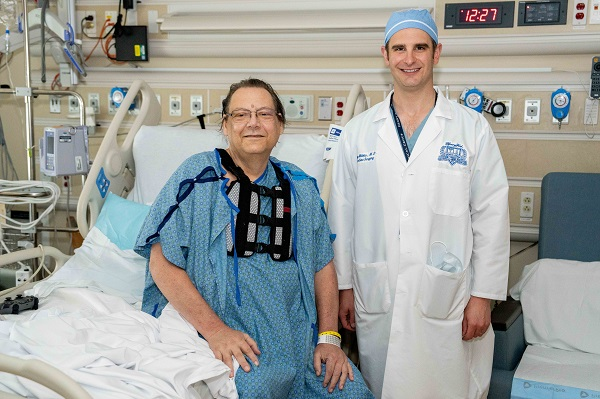Simple 14-question test determines your risk of heart attack in 5 minutes
A home-use questionnaire quickly identifies individuals at high risk of heart attacks with the same level of accuracy as traditional blood tests

The home test comprises 14 questions, taking just five to eight minutes to complete. (CREDIT: Creative Commons)
Swedish researchers have developed a home-use questionnaire that quickly identifies individuals at high risk of heart attacks with the same level of accuracy as traditional blood tests and blood pressure measurements. This innovative tool could revolutionize early detection and prevention of cardiovascular diseases.
The study, published in the Journal of the American Heart Association, utilized data from the Swedish CArdioPulmonary bioImage Study (SCAPIS) based at the University of Gothenburg. The Swedish Heart Lung Foundation is the primary sponsor of this research.
Göran Bergström, a Professor of Clinical Physiology at Sahlgrenska Academy at the University of Gothenburg, senior physician at Sahlgrenska University Hospital, and principal investigator for SCAPIS, led the study. He emphasizes the unpredictable nature of heart attacks, stating, “A heart attack often comes out of the blue. Many of those who suffer heart attacks are apparently healthy and asymptomatic but have fatty deposits in the coronary arteries, known as atherosclerosis. Our test makes it possible to identify almost two-thirds of people aged 50–64 who have significant coronary atherosclerosis and are therefore at high risk of cardiovascular disease.”
The home test comprises 14 questions, taking just five to eight minutes to complete. These questions cover various factors, including age, gender, weight, waist circumference, smoking habits, high blood pressure, high blood fats, diabetes, and family history of cardiovascular disease.
The study found that by combining responses using a specialized algorithm, the home test could detect 65% of individuals at the highest risk of cardiovascular disease. Professor Bergström highlights the significance of these findings: “The results show that our home test is as accurate as a clinic examination using blood tests and blood pressure measurements. If we can make the test widely available within healthcare, it can save lives and prevent suffering by helping us to identify those who are at high risk of heart attack or who are currently undertreated.”
Early Warnings Can Save Lives
The study's data is drawn from 25,000 individuals aged 50–64 who participated in SCAPIS. Each participant had their coronary arteries examined using computed tomography (CT) scans, providing images that reveal the degree of atherosclerosis. By comparing these images with the questionnaire responses, researchers could identify the factors most closely linked to atherosclerosis.
In addition to the Swedish data, the research team has initiated studies in the United States to evaluate the test's effectiveness across different populations. This ongoing research aims to ensure the test's applicability and reliability in diverse groups.
Kristina Sparreljung, Secretary-General of the Swedish Heart Lung Foundation, underscores the importance of early detection: “A test that can provide early warnings would save many lives and a great deal of suffering. The results of Professor Bergström’s study are therefore extremely interesting.”
The Impact of Early Detection
Identifying individuals at high risk before the onset of disease is a key objective of the Swedish Heart Lung Foundation’s SCAPIS project. Early detection allows for timely intervention, which can significantly reduce the risk of heart attacks and other cardiovascular events.
Heart attacks often occur without warning, and many affected individuals appear healthy before the event. Atherosclerosis, the buildup of fatty deposits in the arteries, is a major underlying cause of heart attacks. By identifying those with significant atherosclerosis early, healthcare providers can implement preventive measures to reduce the likelihood of heart attacks.
The new questionnaire test could become a vital tool in preventive cardiology. By enabling early identification of high-risk individuals, it allows for targeted interventions, such as lifestyle changes and medications, to manage risk factors and prevent heart attacks.
The success of the home questionnaire test opens up new possibilities for cardiovascular disease prevention. As researchers continue to validate the test in different populations, its widespread adoption could transform how heart disease is detected and managed.
Professor Bergström and his team are optimistic about the future applications of their work. They envision a healthcare system where individuals can easily assess their risk at home and seek medical advice if needed. This proactive approach could lead to a significant reduction in heart attack rates and improve overall public health outcomes.
The integration of the home questionnaire test into routine healthcare practices could also alleviate the burden on healthcare systems. By identifying high-risk individuals early, resources can be allocated more efficiently, focusing on those who need it most.
As the research continues to validate the test's effectiveness across different populations, it holds promise for widespread adoption in healthcare systems worldwide. Early detection and intervention can save lives, reduce suffering, and improve public health outcomes, making this home questionnaire test a potentially transformative tool in the fight against heart disease.
Note: Materials provided above by the The Brighter Side of News. Content may be edited for style and length.
Like these kind of feel good stories? Get the Brighter Side of News' newsletter.



